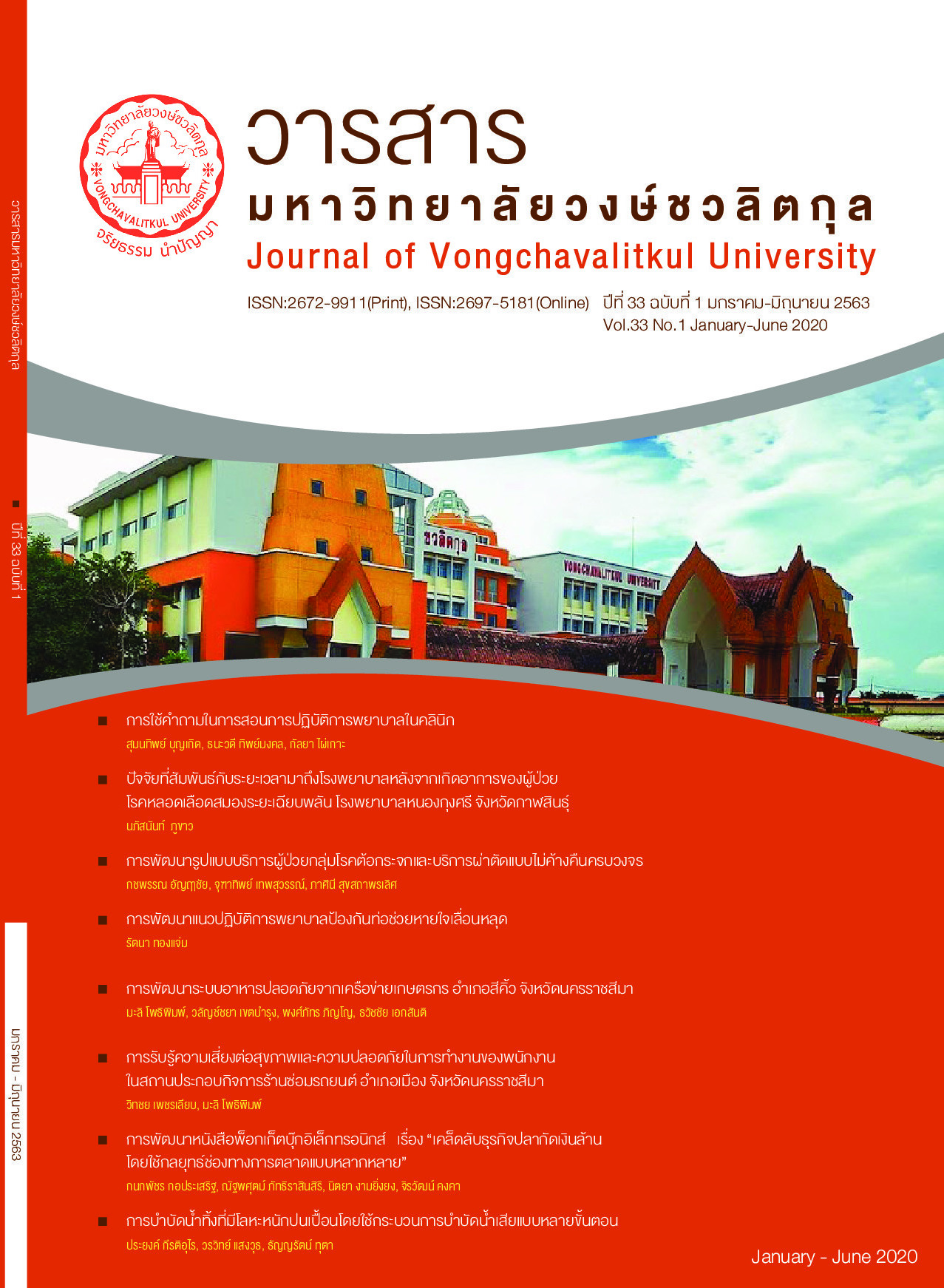Questioning for Teaching in Clinical Nursing Practice
Main Article Content
Abstract
Teaching in clinical nursing practice, a small group learning, focuses on application of theory into practice. This requires students to integrate critical thinking skill and nursing knowledge to provide nursing care. A completion of studying using critical thinking for a student is a result of good questioning of instructors. Identifying problems, using appropriate questions and using questions to stimulate reasoning skill lead students to expand their intellectual and the 21st century learning skills. Good questions would help students to obtain a high level of learning objectives.
Questioning in clinical nursing practice can be performed both in group and individually. Also, it needs several of types of questions to stimulate thinking skill according to each cognitive education objective levels: knowledge, comprehension, application, analysis, synthesis and evaluation. The question techniques that stimulate students to answer the questions by using self-directed learning method and reflective thinking are essential. These process provide students to reconsider, evaluate and analyze themselves in clinical learning situations and revise or improve their clinical practice performance. Still, evaluation of the outcome is the final process that inform the achievement of learning objectives. Observation, interviewing, reviewing assigned papers and anecdotal record are useful techniques to get a complete information of student learning behaviors. Moreover, providing feedback to student are crucial for teachers to maintain learning behavior of the students.
Article Details
References
2. ชนาธิป พรกุล. (2554). การสอนกระบวนการคิดทฤษฎีและการนำไปใช้. (พิมพ์ครั้งที่2). กรุงเทพฯ: บริษัทวี.พรินท์.
3. ทิศนา แขมมณี. (2554). ทักษะการคิดวิเคราะห์ สังเคราะห์ สร้างสรรค์และการคิดอย่างมีวิจารณญาณ: การบูรณาการในการจัดการเรียนรู้. วารสารบัณฑิตยสถาน, 36(2), 188-204.
4. ธีรพงศ์ แก่นอินทร์. (2554). วิธีสอนแบบโสเครติส. วารสารศึกษาศาสตร์ มหาวิทยาลัย สงขลานครินทร์ วิทยาเขตปัตตานี, 22(2), 158-166.
5. บรรจง อมรชีวิน. (2556). เปลี่ยนห้องเรียนให้เป็นห้องคิดด้วยการสืบถามเชิงปรัชญา. กรุงเทพฯ: ภาพพิมพ์
6. ปิยาณี ณ นคร, ดนุลดา จามจุรี, ดรุณี ชุณหวัต และมนัส บุญประกอบ, (2559). การศึกษาแนวทางการจัดการเรียนรู้ผ่านการสะท้อนคิดเพื่อพัฒนากระบวนการคิดอย่างมีวิจารณญาณในนักศึกษาพยาบาล. รามาธิบดีพยาบาลสาร, 44(1), (206-221).
7. พวงรัตน์ บุญญานุรักษ์. (2539). คู่มือการนิเทศการฝึกประสบการณ์วิชาชีพพยาบาล. ชลบุรี: ศรีศิลปการพิมพ์.
8. พิริยลักษณ์ ศิริศุภลักษณ์. (2556). การสอนนักศึกษาเพื่อพัฒนาทักษะการคิดอย่างมีวิจารณญาณ: วารสารวิทยาลัยบรมราชชนนี, 19(2), 5-19.
9. พีรนันท์ วิศาลสกุลวงษ์ และสุมิตตา สว่างทุกข์. (2558). การเรียนรู้ผ่านการสะท้อนกลับการปฏิบัติของนักศึกษาพยาบาลในห้องคลอด. วารสารเกื้อการุณย์, 22(2), 57-69.
10. รังสินี พูลเพิ่ม, จันทนา โปรยเงิน, แสงจันทร์ สุนันต๊ะ และนนทิกา พรหมแป้ง. (2561). ประสิทธิผลการเรียนการสอนโดยใช้คำถามเป็นฐานของผู้เรียนพยาบาล วิทยาลัยพยาบาลกองทัพบก. วารสารพยาบาลทหารบก, 19(3), 126-136.
11. วิยะดา รัตนสุวรรณ. (2547). การพัฒนาหลักสูตรอบรมเพื่อพัฒนาความสามารถในการคิดไตร่ตรองของอาจารย์พยาบาล. ปริญญานิพนธ์การศึกษาดุษฎีบัณฑิต, มหาวิทยาลัยศรีนครินทรวิโรฒ ประสานมิตร.
12. ฤตินันท์ สมุทร์ทัย . วีณา วโรตมะวิชญ์ และเสาวนิตย์ เจริญชัย. (2562). การประเมินตามสภาพจริงของผลการเรียนรู้ตามกรอบมาตรฐานคุณวุฒิอุดมศึกษา ระดับปริญญาตรี สาขาศึกษาศาสตร์. วารสารครุศาสตร์ จุฬาลงกรณ์มหาวิทยาลัย, 47(4), 407-428.
13. Carlson, E., Wann-Hansson, C., Pilhammar, E. (2009). Teaching during clinical practice: Strategies used by preceptors in nursing education. Nurse Education Today, 29(2009), 522-526.
14. Linda, M. Murawski. (2014). Critical Thinking in the classroom and beyond. Journal of Learning in Higher Education, 10(1), 25-30.
15. Navapol Phunthukulratana. (2558). การจัดการเรียนรู้แบบใช้คำถาม (Questioning Method). Retrieved Jan 9, 2020, from https://sites. google.com/site/khunkrunong/n12
16. Nazmi Al-Shalabi. (2009).Critical Thinking Skills: The Recipe for an Overwhelming Success in the 21st Century. International Journal of Humanities and Social Science, 5(8), 102-105.
17. Tofade, T., Elsner, J., & Haines, S. T. (2013). Best practice strategies for effective use of questions as a teaching tool. American Journal of Pharmaceutical Education, 77(7), 155. https://doi.org/10.5688/ajpe777155


